博文
洋壳和陆壳的深俯冲命运:来自地幔相变研究的观点(1)
|||
洋壳和陆壳的深俯冲命运:来自地幔相变研究的观点(1)
The Fate of Subducted Slabs:Perspectives from Studies of Phase Transitions in the Earth’s Mantle
说明:由于本文插图众多,篇幅较长,不得不将原文章拆分为两部分,总共4章,第1章为前言和背景介绍,第2章讨论洋壳物质的深俯冲命运,第3章讨论陆壳物质的深俯冲命运,第4章小结。
1.前言
关于岩石圈(包括大陆岩石圈/地壳和大洋岩石圈/地壳)的深俯冲命运,是板块构造和地球动力学研究的永恒的话题。岩石圈的深俯冲命运,不可能单一地由某一地学学科(地球化学、地球物理、实验岩石学等)得到完整解释,必须结合多方面的研究成果来认识。本人学识有限,不可能面面俱到,在这里仅从地幔相变研究出发,来稍微做一点介绍。
由于本文讨论是以地幔相变为基础的,因此需要对基本的地幔矿物学知识有所了解才便于理解,大家可以参考本博《地球内部的基本基本结构和物质组成》 http://bbs.sciencenet.cn/home.php?mod=space&uid=92454&do=blog&id=408337 及文后参考文献,以及费英伟(2002)的文章(见参考文献);另外最重要的三类岩石的相变,即pyrolite(地幔岩)、方辉橄榄岩和玄武岩(MORB)体系的相变,本博上一篇文章《地幔相变 Phase transitions in the Earth’s Mantle》 http://bbs.sciencenet.cn/home.php?mod=space&uid=92454&do=blog&id=419398 已经对此进行了介绍。需要强调地是,本文讨论是以《地幔转换带:地球深部研究的重要方向》一文中的3.5.2节“洋壳和陆壳的深俯冲命运”为主体而展开的,同时加入了更多的原始参考文献数据和图解,内容更加详实丰富。
本文将首先分别讨论洋壳和陆壳物质的深俯冲命运,然后结合Komabayashi等(2009)的文章对其他的代表性岩石的密度-深度剖面进行简单介绍。另外,由于实验条件有限,相关的岩石在下地幔条件下的高温高压相变实验报道很少,本文也将以作者所了解的文献为基础稍作说明。
2.大洋岩石圈的深俯冲
要认识大洋岩石圈的深俯冲命运,首先要对大洋岩石圈的基本结构有所了解。如图1所示,根据Ringwood的模型(e.g. Ringwood and Irifune,1988),大洋岩石圈顶部是一层几公里的相对较薄的玄武岩层(MORB),玄武岩层下面为20多公里厚的方辉橄榄岩层,更下部的为二辉橄榄岩以及“亏损”地幔岩成分物质。在大洋岩石圈深俯冲过程中,二辉橄榄岩以及“亏损”地幔岩层由于物质组成和性质与周围地幔相近,而将会被吸收进入周围地幔环境中,因此,玄武质洋壳(MORB)和方辉橄榄岩的性质变化决定着大洋板块深俯冲的最终命运。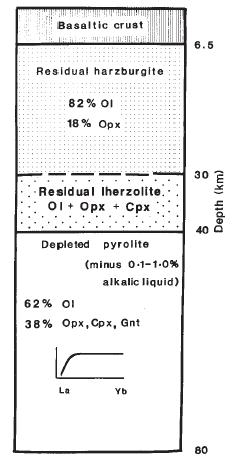
图1. 大洋岩石圈结构图(from Ringwood and Irifune,1988)
2.1玄武质洋壳(MORB)深俯冲命运 The fate of subducted basaltic crust 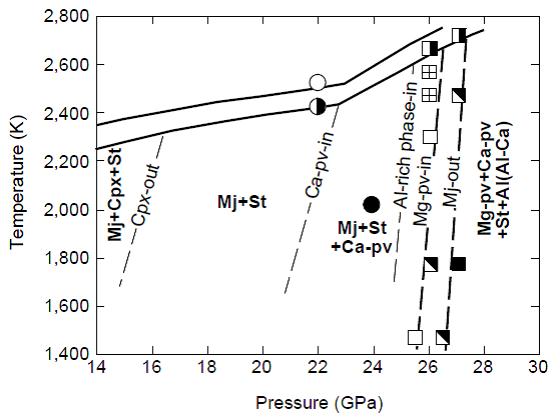
图2. Phase relations in MORB composition up to 27GPa. Solid lines represent solidus and liquidus temperatures.(Hirose et al.,1999)
图3. Mineral proportions (wt%) in MORB as a function of depth (Perrillat et al.,2006). The solid circles represent the phase proportions estimated in this study from Rietveld refinement of the in situ XRD spectra at 2050 K. Previous estimates by Ono et al. (2001), Hirose et al. (1999) and Irifune and Ringwood (1993) are reported as squares, triangles and open circles, respectively. Mineral abundances at shallower depth region are taken from Irifune et al.(1986).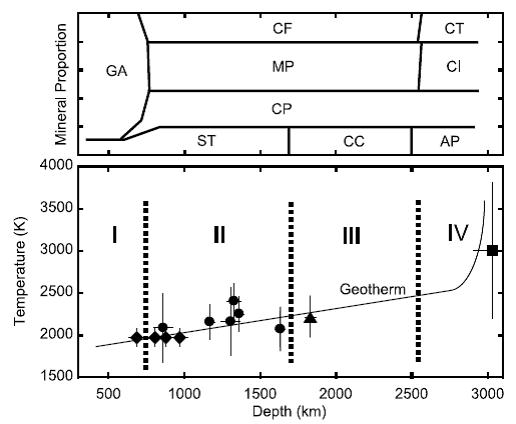
图4. Experimental conditions and schematic phase relation of NMORB (Ono et al.,2005). Phase assemblages are solid circles, Mg perovskite + Ca perovskite + stishovite + CaFe2O4- type aluminous phase; solid triangle, Mg perovskite + Ca perovskite + CaCl2-type silica + CaFe2O4-type aluminous phase; solid square, CaIrO3-type (Mg,Fe)SiO3 + Ca perovskite + a-PbO2-type silica + CaTi2O4-type aluminous phase. Solid diamonds present results from previous multianvil experiments [Ono et al., 2001]. Abbreviations in the diagram of phase relation are GA, majoritic garnet; CF, CaFe2O4-type aluminous phase; MP, Mg perovskite; CP, Ca perovskite; ST, stishovite; CC, CaCl2-type silica; CT, CaTi2O4-type aluminous phase; CI, CaIrO3-type (Mg,Fe)SiO3; AP, a-PbO2-type silica.
玄武质洋壳(MORB)体系在地幔中的相变可以参考图2(上地幔),3(下地幔上部)和4(下地幔)。
随着俯冲深度的增加,其中的辉石会逐渐转变为石榴石,玄武岩相变为榴辉岩,而榴辉岩的密度超过了地幔橄榄岩(pyrolite)的密度,驱动着洋壳进一步俯冲到更深的地幔转换带底部(图5;Irifune and Ringwood,1993; Ringwood and Irifune,1988)。但是在转换带底部660处,地幔中的矿物林伍德石相变分解形成更高压高密度的矿物集合体(钙钛矿和镁方铁矿),而MORB由于Al含量比pyrolite更高,致使其中石榴石(majorite)的能够保持稳定至800km深度,石榴石密度比钙钛矿密度低~10%,那么俯冲洋壳的密度将小于周围地幔的密度,成为洋壳穿越转换带底部不连续面的阻碍(图5,6,7)。但是当MORB中的石榴石在27GPa左右完全相变为钙钛矿后,下地幔中MORB的密度将再次大于周围地幔密度(图6,7)。如果俯冲洋壳在转换带底部/上地幔顶部堆积能够突破浮力阻碍而进入下地幔,将可能继续俯冲至核幔边界(图8)。
图5. Density differences between MORB and pyrolite compositions and between harzburgite and pyrolite compositions as a function of depth. (Irifune and Ringwood,1993)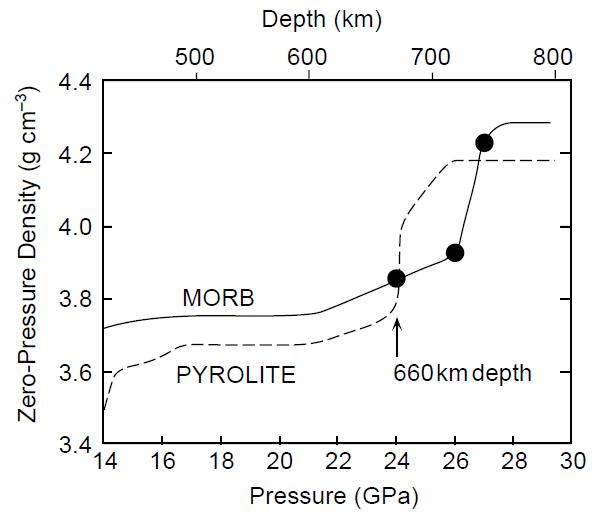
图6. Comparison of zero-pressure density changes in MORB (solid line) and pyrolite (dashed line) (Hirose et al.,1999). Solid circles represent the calculated densities at 24, 26 and 27GPa from X-ray diffraction and microprobe data. The density profle of pyrolite is from a previous study(Irifune and Ringwood,1987). Pyrolite becomes denser than MORB at 660km depth because of the transformation to perovskitite lithology, but once MORB transforms to perovskitite at 720km depth, it is no longer buoyant in the deep mantle.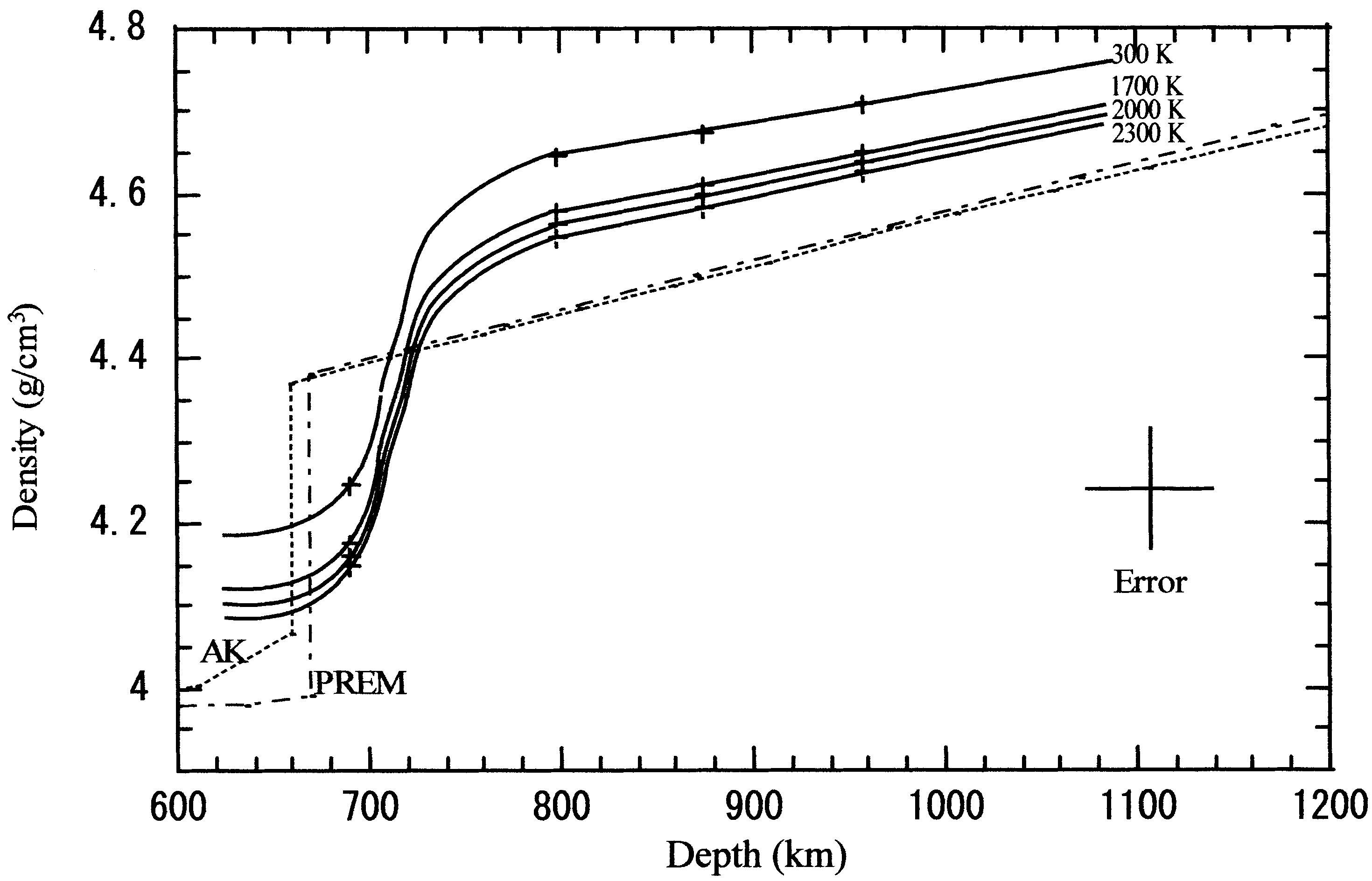
图7. Comparison of calculated densities in MORB, with average mantle densities based on seismic observations (Ono et al.,2001). It was assumed that the proportions of major phases remained constant for different temperatures. Solid lines represent the isothermal density profiles. The average mantle densities are from Dziewonski and Anderson (1981): PREM and Kennett et al.(1995): AK.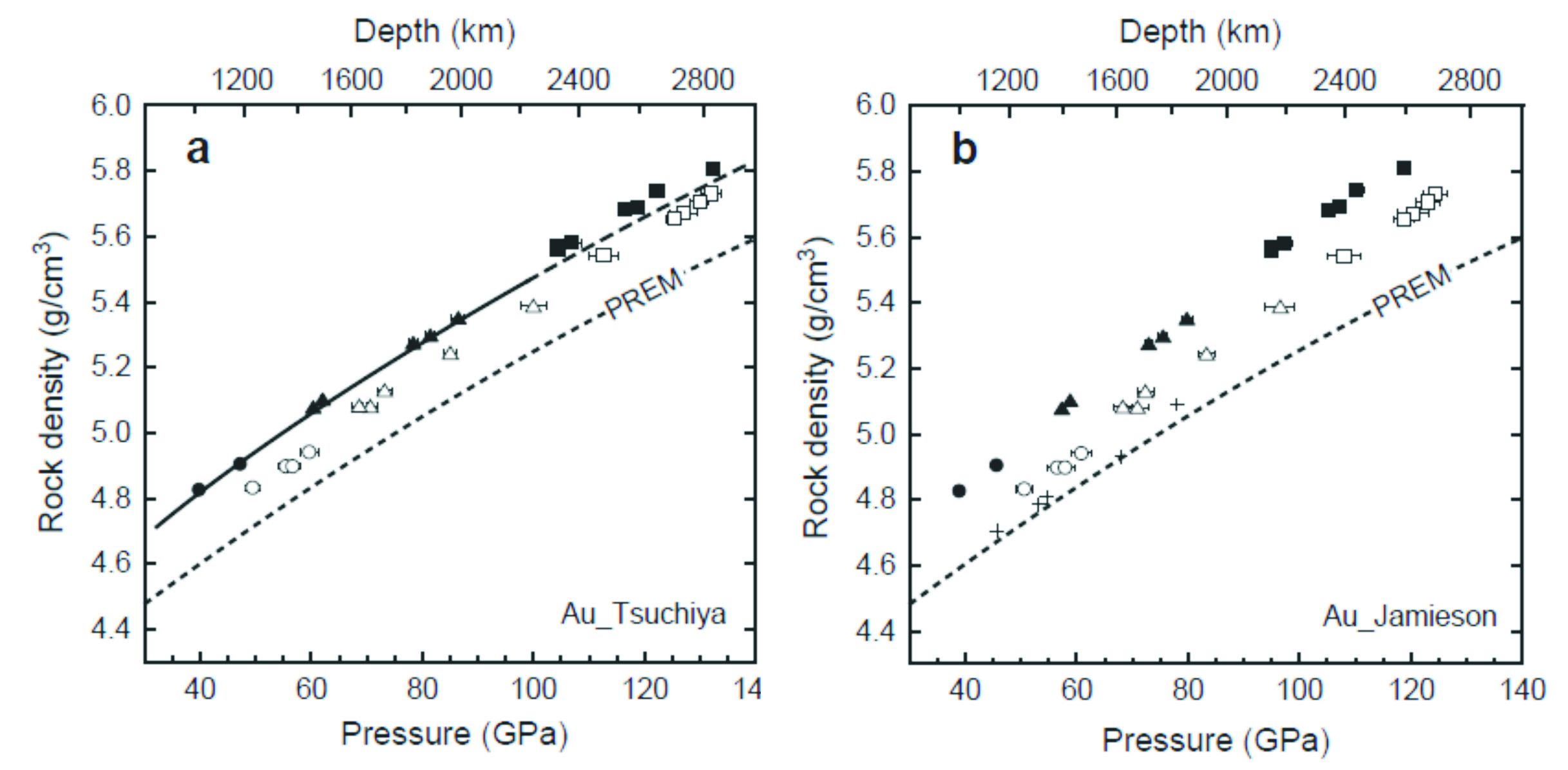
图8. Net density profile of MORB composition.(Hirose et al.,2005) Pressure was calculated based on EOS of gold proposed by (a) Tsuchiya (2003) and by (b) Jamieson et al. (1982). Circles, MgPv+St+CaPv+CF; triangles, MgPv+CaCl2-type SiO2+CaPv+CF; squares, MgPP+a-PbO2-type SiO2+CaPv+CF. Closed and open symbols indicate 300 K and high temperature (1750–2290 K) data, respectively. Broken lines indicate the PREM density. The error of density is typically 0.02 g/cm3, derived from the uncertainties in volumes of coexisting phases and in mineral proportion. (a) Solid line shows a density profile at 300 K for perovskite-dominant assembly fitted to the Birch–Murnaghan equation of state. (b) Data by Ono et al. (2005) using Jamieson’s gold scale were shown for comparison (pluses). Slightly lower density reported by Ono et al. (2005) is primarily due to the lower density of CaFe2O4-type Al-phase with a different chemical composition.
2.2 大洋岩石圈方辉橄榄岩层的深俯冲命运 The fate of subducted harzburgite layer
方辉橄榄岩是俯冲大洋岩石圈中的另一种重要的岩石,它在俯冲过程中与MORB的相变行为不同。方辉橄榄岩的相变见图9.
图9. Mineral proportion changes in a harzburgite compositions as a function of pressure. (Irifune and Ringwood,1987) Opx = orthoenstatite; Cpx = clinoenstatite; St =stishovite; llm = ilrnenite.
根据前人的研究结果(Irifune and Ringwood,1987; Ringwood and Irifune,1988),在660以上,方辉橄榄岩密度始终都小于pyrolite(图 10),这是由于方辉橄榄岩比pyrolite中Fe和Al含量均相对较低,而Al是高密度的石榴石的主要成分之一。在下地幔顶部(24-26GPa),同样由于pyrolite中Al使石榴石稳定至更深部,方辉橄榄岩的密度才略大于周围地幔以及MORB的密度。但是随着pyrolite和MORB中石榴石在27GPa左右完全转变成钙钛矿,此后一直到核幔边界,方辉橄榄岩的密度将始终略微小于相同深度的下地幔岩石(图11)。但是这并不能简单地就此而认为方辉橄榄岩完全无俯冲至下地幔的可能,且看下面的分析。
图10. Density profiles in the harzburgite, MORB and pyrolite compositions along the geotherm as a function of depth. (Irifune and Ringwood,1987)
图11. Bulks density variations of pyrolite, hartzburgite, and MORB calculated, based on the PVT-EoS of constituent mineral phases and their proportions (refer to the paper for details). Broken lines at pressures lower than 30 GPa are results in Irifune (1993).(from Irifune and Tsuchiya,2007)
根据Ringwood的大洋岩石圈模型,Irifune和Ringwood(1987,1988)将玄武岩(MORB)和方辉橄榄岩以1:4的比例(图1,玄武岩和方辉橄榄岩层厚度比大约为1:4)混合来代表深俯冲洋壳的组分,研究俯冲洋壳与周围地幔的密度关系,结果发现在650km以上俯冲洋壳始终比pyrolite密度大,但在下地幔顶部密度关系又倒转过来,而在下地幔700km左右洋壳的密度将再次大于pyrolite,在此深度以下,二者的密度非常接近(图12)。以上结果表明,影响洋壳深俯冲最终命运的关键问题在于能否突破地幔转换带底部的浮力障碍。
图12. Density differences between subducted slab and surrounding mantle. (Ringwood and Irifune,1988) The slab is assumed to consist of 20% basalt and 80% harzburgite and to be cooler than surrounding mantle by 800°C at 400 km and by 400°C at 650 km, attaining thermal equilibrium with surrounding mantle at ~900 km. The surrounding mantle follows the geotherm of Brown and Shankland (1981) and consists of pyrolite above 600 and below 700 km. Between these depths the mantle consists of a pre-existing layer of basalt and harzburgite (图13).
Ringwood和Irifune则提出在转换带底部,俯冲的洋壳物质(玄武岩和方辉橄榄岩)可能在660附近堆积而形成一个“巨石”(megalith)(图13;Ringwood and Irifune,1988),这些堆积或残留在转换带底部的洋壳物质及“巨石”可以在横向和纵向上伸展,很可能与所观测到的地震波异常有关;温度相对较低的“巨石”由于高密度而将沉入下地幔中。但是俯冲的洋壳与周围地幔的密度关系非常复杂,相边界的压力-温度斜率此时具有重要意义:转换带底部的主要矿物相是林伍德石和石榴石(majorite),后尖晶石相变和石榴石-钙钛矿相变分别具有负的和正的P-T斜率(Clapeyron Slope),而俯冲带内(或者“巨石”)温度相对周围地幔要低300-400℃,那么意味着在下地幔顶部pyrolite中林伍德石转变成高密度的钙钛矿和镁方铁矿矿物组合后,俯冲带内相对低密度的林伍德石(橄榄石组分)仍可能保持稳定而未发生分解,而石榴石成分则可能已经转变成更高密度的钙钛矿了,由此俯冲带内林伍德石和石榴石组分此时将分别产生正的和负的浮力,二者综合作用的效果尚需进一步的研究。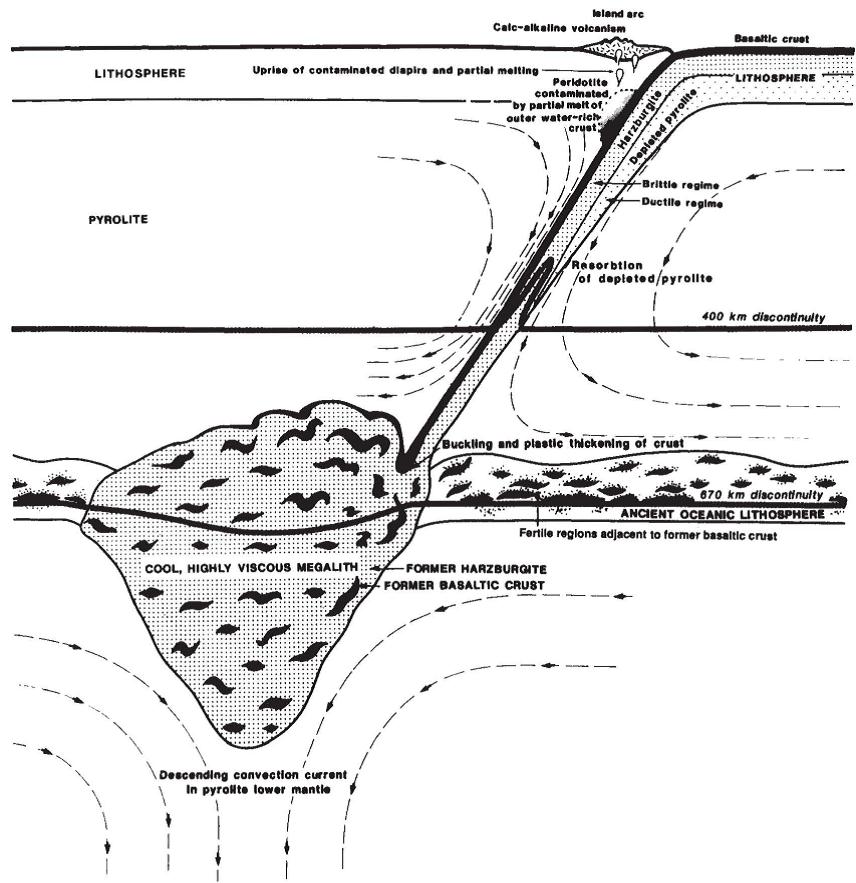
图13. Model showing subduction of a cool, thick plate of differentiated oceanic lithosphere. Previous subduction episodes involving thin, thermally equilibrated plates have produced a layer of former harzburgite and basalt ('ancient oceanic lithosphere') between 600 and 700 km. The tip of a cool, thick plate experiences buoyant resistance when it penetrates this layer and encounters the discontinuity at 650 km (the 670-km discontinuity in the above figure should read 650-km discontinuity). At that depth the fonner oceanic crust and harzburgite layers may plastically thicken and buckle to form a large melange (megalith) situated mainly below the seismic discontinuity. The megalith is a transient feature and ultimately becomes entrained in the convective regime of the lower mantle. The lower layer of ductile depleted pyrolite initially at the base of the descending plate of sub-oceanic lithosphere becomes resorbed into the upper mantle by convective circulation owing to its inability to penetrate the harzburgite-basalt layer at 600-700 km because of the buoyancy relationships. (from Ringwood and Irifune,1988)
(未完,下文见《洋壳和陆壳的深俯冲命运:来自地幔相变研究的观点(2)》 http://bbs.sciencenet.cn/home.php?mod=space&uid=92454&do=blog&id=423022 )
参考文献:
费英伟, 2002. 地幔中的相变和地幔矿物学. In: 张有学 and 尹安 (Editors), 地球的结构、演化和动力学. 高等教育出版社, 北京, pp. 49-90.
周春银,金振民,章军锋,2010,地幔转换带:地球深部研究的重要方向,地学前缘, 17(3),90-113.
Aoki, I. and Takahashi, E., 2004. Density of MORB eclogite in the upper mantle. Physics of the Earth and Planetary Interiors, 143-144: 129-143.
Dziewonski, A.M. and Anderson, D.L., 1981. Preliminary reference Earth model. Physics of the Earth and Planetary Interiors, 25(4): 297-356.
Kennett, B.L.N., Engdahl, E.R. and Buland, R., 1995. Constraints on seismic velocities in the Earth from traveltimes. Geophysical Journal International, 122(1): 108-124.
Hirose, K., Fei, Y., Ma, Y. and Mao, H.-K., 1999. The fate of subducted basaltic crust in the Earth's lower mantle. Nature, 397(6714): 53-56.
Irifune, T., Sekine, T., Ringwood, A.E. and Hibberson, W.O., 1986. The eclogite-garnetite transformation at high pressure and some geophysical implications. Earth and Planetary Science Letters, 77(2): 245-256.
Irifune, T. and Ringwood, A.E., 1987. Phase transformations in a harzburgite composition to 26 GPa: implications for dynamical behaviour of the subducting slab. Earth and Planetary Science Letters, 86(2-4): 365-376.
Irifune, T., 1993. Phase transformations in the earth's mantle and subducting slabs: Implications for their compositions, seismic velocity and density structures and dynamics. The Island Arc, 2(2): 55-71.
Irifune, T. and Ringwood, A.E., 1993. Phase transformations in subducted oceanic crust and buoyancy relationships at depths of 600-800 km in the mantle. Earth and Planetary Science Letters, 117(1-2): 101-110.
Irifune, T., Ringwood, A.E. and Hibberson, W.O., 1994. Subduction of continental crust and terrigenous and pelagic sediments: an experimental study. Earth and Planetary Science Letters, 126(4): 351-368.
Irifune T, Tsuchiya T, 2007. Mineralogy of the Earth – Phase Transitions and Mineralogy of the Lower Mantle, Treatise on Geophysics,vol2,Mineral Physics,33-62.
Jamieson J.C., Fritz J.N., Manghnani M.H., Pressure measurement at high temperature in X-ray diffraction studies: gold as a primary standard, in: S. Akimoto, M.H. Manghnani (Eds.), High-Pressure Research in Geophysics, CAPJ, Tokyo, 1982, pp. 27– 48.
Komabayashi, T., Maruyama, S. and Rino, S., 2009. A speculation on the structure of the D'' layer: The growth of anti-crust at the core-mantle boundary through the subduction history of the Earth. Gondwana Research, 15(3-4): 342-353.
Ono, S., Ito, E. and Katsura, T., 2001. Mineralogy of subducted basaltic crust (MORB) from 25 to 37 GPa, and chemical heterogeneity of the lower mantle. Earth and Planetary Science Letters, 190(1-2): 57-63.
Ono, S., Ohishi, Y., Isshiki, M. and Watanuki, T., 2005. In situ X-ray observations of phase assemblages in peridotite and basalt compositions at lower mantle conditions: Implications for density of subducted oceanic plate. J. Geophys. Res., 110: B02208,doi:10.1029/2004JB003196.
Ringwood, A.E. and Irifune, T., 1988. Nature of the 650-km seismic discontinuity: implications for mantle dynamics and differentiation. Nature, 331(6152): 131-136.
Tsuchiya T, First-principles prediction of the P–V–T equation of state of gold and the 660-km discontinuity in Earth’s mantle, J. Geophys. Res. 108 (2003) , doi:10.1029/2003JB002446.
Wu, Y., Fei, Y., Jin, Z. and Liu, X., 2009. The fate of subducted Upper Continental Crust: An experimental study. Earth and Planetary Science Letters, 282(1-4): 275-284.
https://blog.sciencenet.cn/blog-92454-422988.html
上一篇:地幔相变 Phase Transitions in the Earth's Mantle
下一篇:洋壳和陆壳的深俯冲命运:来自地幔相变研究的观点(2)